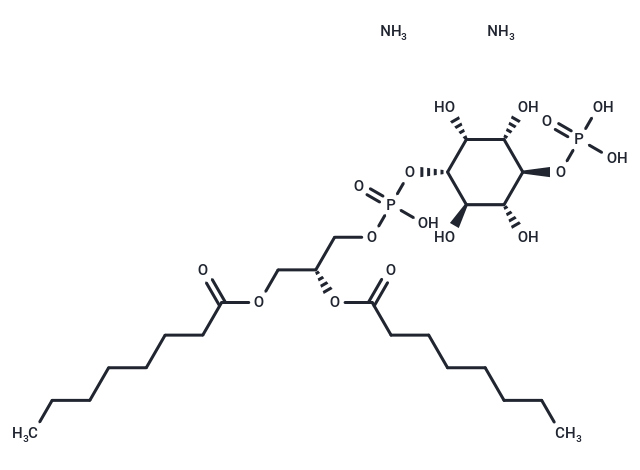- 全部删除
 您的购物车当前为空
您的购物车当前为空
PtdIns-(4)-P1 (1,2-dioctanoyl) (ammonium salt)
The phosphatidylinositol (PtdIns) phosphates represent a small percentage of total membrane phospholipids. However, they play a critical role in the generation and transmission of cellular signals. PtdIns-(4)-P1 (1,2-dioctanoyl) is a synthetic analog of natural phosphatidylinositol (PtdIns) featuring C8:0 fatty acids at the sn-1 and sn-2 positions. The compound contains the same inositol and diacylglycerol (DAG) stereochemistry as the natural compound. PtdIns-(4)-P1 can be phosphorylated to di- (PtdIns-P2; PIP2) and triphosphates (PtdIns-P3; PIP3). Hydrolysis of PtdIns-(4,5)-P2 by phosphoinositide (PI)-specific phospholipase C generates inositol triphosphate (IP3) and DAG which are key second messengers in an intricate biochemical signal transduction cascade.

PtdIns-(4)-P1 (1,2-dioctanoyl) (ammonium salt)
The phosphatidylinositol (PtdIns) phosphates represent a small percentage of total membrane phospholipids. However, they play a critical role in the generation and transmission of cellular signals. PtdIns-(4)-P1 (1,2-dioctanoyl) is a synthetic analog of natural phosphatidylinositol (PtdIns) featuring C8:0 fatty acids at the sn-1 and sn-2 positions. The compound contains the same inositol and diacylglycerol (DAG) stereochemistry as the natural compound. PtdIns-(4)-P1 can be phosphorylated to di- (PtdIns-P2; PIP2) and triphosphates (PtdIns-P3; PIP3). Hydrolysis of PtdIns-(4,5)-P2 by phosphoinositide (PI)-specific phospholipase C generates inositol triphosphate (IP3) and DAG which are key second messengers in an intricate biochemical signal transduction cascade.
| 规格 | 价格 | 库存 | 数量 |
|---|---|---|---|
| 100 μg | ¥ 1,100 | 35日内发货 | |
| 500 μg | ¥ 4,810 | 35日内发货 | |
| 1 mg | ¥ 8,500 | 35日内发货 |
产品介绍
| 产品描述 | The phosphatidylinositol (PtdIns) phosphates represent a small percentage of total membrane phospholipids. However, they play a critical role in the generation and transmission of cellular signals. PtdIns-(4)-P1 (1,2-dioctanoyl) is a synthetic analog of natural phosphatidylinositol (PtdIns) featuring C8:0 fatty acids at the sn-1 and sn-2 positions. The compound contains the same inositol and diacylglycerol (DAG) stereochemistry as the natural compound. PtdIns-(4)-P1 can be phosphorylated to di- (PtdIns-P2; PIP2) and triphosphates (PtdIns-P3; PIP3). Hydrolysis of PtdIns-(4,5)-P2 by phosphoinositide (PI)-specific phospholipase C generates inositol triphosphate (IP3) and DAG which are key second messengers in an intricate biochemical signal transduction cascade. |
| 别名 | PtdIns-(4)-P1 (1,2-dioctanoyl) (ammonium salt) |
| 分子量 | 700.653 |
| 分子式 | C25H54N2O16P2 |
| CAS No. | 1246303-11-6 |
| 存储 | Powder: -20°C for 3 years | In solvent: -80°C for 1 year | Shipping with blue ice. |
| 溶解度信息 | DMSO: Soluble |





 还可以
还可以

评论内容